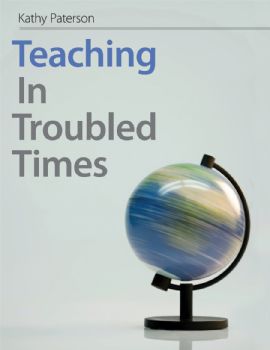| ________________
CM . . . . Volume XVII Number 24. . . .February 25th, 2011. 
 |
Teaching in Troubled Times.
Kathy Paterson.
Markham, ON: Pembroke, 2010.
128 pp., pbk., $24.95.
ISBN 978-1-55138-254-8.
Subject Headings:
Teaching.
Teaching effectiveness.
Professional.
Review by Jocelyn A. Dimm.
*** / 4
|
| |
|

excerpt:
It seems today’s students suffer from a triple dose of nastiness: from the world, from their peers, and from themselves; yet if they are to evolve into successful adults, they must learn to deal with and ultimately, overcome, the problems in their existence. The operative word is “learn”, which leads to school and to teachers.
Teaching in Troubled Times is a practical manual for teachers or anyone dedicated to the education of children. In the preface of her book, Paterson begins with an exploration of fear which underlies all of the troubles experienced by students, teachers, and parents (p. 5). Each chapter is focussed on a specific concern:
Concerning Fear (Chapter 1)
Concerning the World (Chapter 2)
Concerning Children of the New Decade (Chapter 3)
Concerning New-Age Teachers (Chapter 5)
Concerning Schools in 2010 and Beyond (Chapter 6)
Paterson states her book is based on four premises (p. 7):
Teachers are busy, overworked individuals who are concerned with the welfare of students
When a child has serious worries, questions, or fears, teachers want to be comfortable with how and when to step in, how much assistance to offer, and what techniques or strategies work.
Our world is a world of chaos, where fear runs rampant – children are affected by that.
For teachers seeking the best possible ways to help their students handle concerns and fears, there is far too much information available.
She seeks to provide quick, easy-to-use, and effective strategies that teachers can use on the spot, if needed. Each chapter consists of what Paterson calls, “Formula Fives, five helpful ideas that can be shared with students or parents, or used as teacher background; “Good Idea notes” that are suggestions to increase the effectiveness
Many of the strategies outlined in Paterson’s book will be familiar; especially to drama teachers and teachers who are familiar with experiential learning (Paterson identifies herself as a dramatist), and so it is surprising Paterson doesn’t include a reference list in the back of the book acknowledging the sources of these strategies. One point that may cause reader frustration is that Paterson doesn’t try to break down the strategies into any specific grade levels. Consequently, it is up to the reader of this book to choose which activities will suit which grade levels. Having said that, the strength of this book does seem to lie in the way it is organized under headings and into chapters on specific concerns with activities and personal anecdotal stories focussed on those concerns. It should be pointed out, though, that there is an awkward title choice for Chapter 5, “Concerning New-Age Teachers”, as ‘New-Age’ is a term often associated with alternative spiritual practices, and the chapter neither defines the term nor focuses on spiritual meanings. Some of the above mentioned points might deter potential readers.
Teaching in Troubled Times offers a significant collection of ideas and activities to consider for classroom study. The collection does come from Paterson’s years of experience as a teacher and a consultant; however, it is important for any educator to remember that, unless s/he is a licensed therapist or counsellor, some strategies may be too personal and or too sensitive to explore safely with students in a classroom situation.
Teaching in Troubled Times contains many valuable comments, ideas, and strategies for teachers to read through and to decide upon the applicability of those materials for their own classrooms. A good collection to consider with other related resources.
Recommended.
Jocelyn A. Dimm is a sessional instructor and doctoral candidate at the University of Victoria in Victoria, BC, where she teaches drama education and young adult literature in the Faculty of Education.

To comment on this title or this review, send mail to
cm@umanitoba.ca.
Copyright © the Manitoba Library Association. Reproduction for personal use is permitted only if this copyright notice is maintained. Any other reproduction is prohibited without permission.
NEXT REVIEW |
TABLE OF CONTENTS FOR THIS ISSUE- February 25, 2011.
AUTHORS |
TITLES |
MEDIA REVIEWS |
PROFILES |
BACK ISSUES |
SEARCH |
CMARCHIVE |
HOME |
